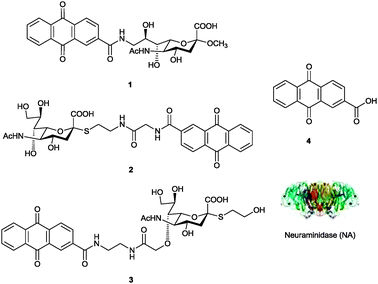In the fight against influenza, viral neuraminidase (NA) represents an important target. This enzyme is essential for the replication of the virus, and its inhibition can prevent the spread of the disease. Scientists at Keio University have now identified a set of novel anthraquinone–sialic acid hybrids which can inhibit influenza virus neuraminidase with photo-irradiation under neutral conditions.
Anthraquinone derivatives were found to degrade proteins when subjected to photo-irradiation; this degradation is likely caused by hydroxy radicals which are produced from the photolysis of anthraquinone and oxygen. Crucially, researchers led by Prof. Kazunobu Toshima proposed that NA-inhibition could be obtained if such an anthraquinone derivative could be tethered to an NA-binding moiety. Sialic acid is a native ligand for NA— both “normal” NA and drug-resistant NA— and so researchers prepared and investigated a number of anthraquinone–sialic acid hybrids (1–3).
These hybrids were found to be effective for the inhibition of NA under photo-irradiation, and interestingly, showed comparable or superior results compared to the leading anti-NA drug, especially in the inhibition of drug-resistant NA. While further tests are ongoing, this research represents an important advance in influenza treatment, and offers great potential for the inhibition of other disease targets.
For more, read this ‘HOT’ ChemComm article in full:











